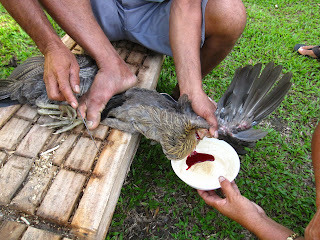“Elvis,” my grandma answered.
I remember asking that question when I was a 12 years old. At that time, my sisters and I were vacationing in the farm of my grandparents up in the mountains of Leyte. It was the farm where my mother grew up on with nine other siblings-- not counting several half-brothers and sisters. But that makes for another story.
When you come from the city, all animals are considered pets and should have a name—hence the question. Coming from the city, the farm was both scary and exciting all at once. Scary for fear that a cobra could be lurking behind our back as we used the outhouse (outdoor toilet);

exciting because there was always something to discover—turtles in a nearby stream and the cows that come late in the afternoon to lick salt from our hands.

As we were growing up, my father insisted we conversed in English. And since my grandmother hardly had any formal education, she tried to respond to our questions as best as she could. But what she lacked in proficiency in the English language she more than made up for it with her knowledge about what really mattered in life: how to raise a large family on the meager earnings of a poor farm, how to deal with a fair amount of hardships and tragedies; and eventually, later in life, how to manage a community as barangay captain.

She was a quiet person but not timid. She was firm with her decisions but tempered them with tenderness. She was the type of person whose one-liners were meaningful and most often humorous.
As we grew up, my mother made it a point to bring us to her parent’s farm every summer. There were always new paths to walk through the fields.

These visits continued well into our high school years but, over the years, sadly became less and less as my siblings and I found it difficult to visit— either due to work or migration to foreign countries.
Now that I have time on my hands, I look forward to visiting my grandmother’s farm on a regular basis. Only recently, I was sitting at the terrace of my grandmother’s house trading stories with my mother and her siblings—aunts and uncles well into their 70s.

There is always so much happy reminiscing to be done and something funny to laugh about. And at night, a cacophony of sounds made by the crickets, the giant geckos, cicadas and owls is music to my city ears.

By the way, Elvis grew up to be a strong carabao. In the following summer when we returned for our annual visit, I rode on its back. And boy was I surprised to learn that Elvis had given birth to a fine calf.

¤~ ¤~ ¤~ ¤~ ¤~ ¤~ ¤~ ¤~ ¤~ ¤~ ¤~ ¤~ ¤~ ¤~ ¤~ ¤~
The following is a dish which my grandmother use to prepare when we would come to visit. When I asked her the name, she said that she called it “Rhapsody”. And rightly named so as one taste and you’re sure to hear a rhapsody.
Rhapsody
1 live native chicken
Blood of native chicken
3 cloves garlic, chopped
1 med-size onion, chopped
Coconut milk from a grated coconut
1 stalk lemon grass, tied up in a neat bundle
Some sliced ginger (about a thumb-size)
1 sili espada (green chili-- optional)
A bunch of young bago leaves( edible leaves of Gnetum gnemon Linn) or leaves of a sili (pepper) plant or a cup of malonggay leaves
Salt and pepper to taste
Step 1: The native chicken must go thru cleansing for about 1 week. It is caged and not allowed to roam around. It is feed some corn and given water.
The chicken is then slaughtered and its blood collected in a saucer. The chicken is then dressed (funny that when you dress a chicken, you remove its feathers). Finally the chicken is cut up into serving pieces and set aside. In the province, nothing goes to waste as the head and the feet are cleaned and included in the stew but this is optional.

Step 2: In a bowl, place the meat of a grated coconut. Add the blood and about a cup of warm water. Mix and squeeze the grated coconut. The resulting milk will be a nice shade of pink. Pour the milk thru a sieve. Set aside.

Step 3: Saute the garlic, onion and ginger in a little oil (1/2- 1 T). Add the chicken pieces, 2 cups of water and the lemon grass bundle. Bring to a boil then lower flame so that the stew simmers until the chicken is very tender.

Step 4: Add the coconut milk, the sili espada (optional) and the bago or sili leaves or malongay/kamonggay leaves. Continue to simmer for about 3-5 minutes.
Step 5. Season with some salt and pepper. Remove the lemon grass bundle and serve piping hot with lots of rice. Prepare for a rhapsody of flavors.

Note:
Bago- is a medium size tree with edible young leaves. Grown mostly in backyards in the provinces.


No comments:
Post a Comment